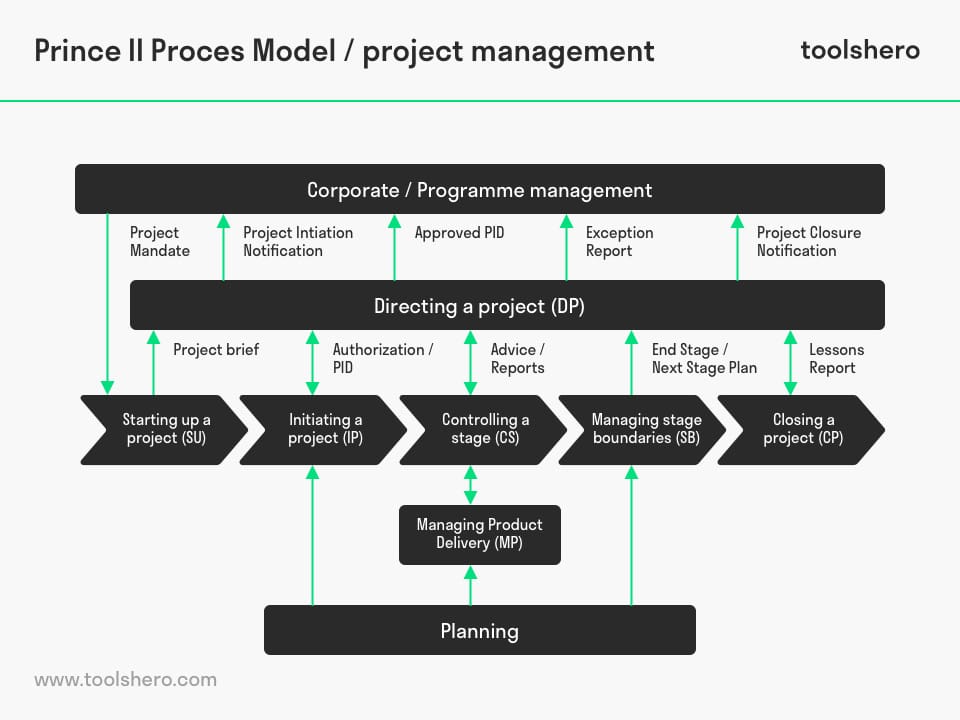Prince2 Methodology: Phases an Principles

Prince2 methodology: this article explains Prince2 in a practical way. After reading you will understand the basics of this project management methodology. Furthermore, this article contains a basic definition and explanation of the method, including the 7 phases and principles. Enjoy reading!
What is Prince2?
A PROJECT IN Controlled Environments (PRINCE) is a project management method. It is related to the management, monitoring and organization of a project Prince2 refers to the second large version of this method. It is also a registered trademark of the Office of Government Commerce (OGC), an independent branch of the HM Treasury of the United Kingdom.
A project is often complex because many processes are being carried out at the same time. The Prince2 project management methodology relates to the management, monitoring and organization of a project and makes these processes transparent.
Prince2 foundation refers to the second, renewed version of this method and has been adopted as a registered trademark of the Office of Government Commerce (OGC) in Great Britain. Prince2 is also often combined with agile principles. In this case, the method i-is referred to as Prince2 Agile.
Prince2, a Structural approach
Prince2 is an automation method to manage a project according to a structured approach and clearly defined parameters. It describes procedures for the coordination and supervision of people and activities within a project environment and it provides points of reference for the adjustments of a project when this does not proceed according to plan.
The input and output of each sub activity are indicated separately. This project management methodology also performs automatic checks on any deviations.
Clear
Prince2 divides a project into manageable stages because of which there is close supervision. Because of this structured method, Prince2 provides a common language for all participants.
In addition, their skills are linked to the complexity of a project. In the Prince2 diagram, the arrows reflect the information flows:

Figure 1 – Prince2 Model
Put together in a clear way
Prince2 divides a project into manageable phases, allowing for tight supervision. Due to this structured method, Prince2 provides all participants with a common language. Their skills are also matched to the complexity of a project. In the Prince2 diagram, the arrows represent the various flows of information.
In addition to the seven phases of project management in Prince2, this article will also discuss the basis of this project management approach as well as the various themes woven into the methodology by the founders of Prince2.
The 7 phases of project management using the Prince2 methodology
Prince2 can be defined based on seven processes. It encompasses the project’s evolution from start to finish. In this, each process has its own agenda, its own demands, different responsibilities, activities etc.
The Project Manager oversees these seven previously mentioned principles, and ensures that everything remains up to date on the task board. Below is an overview of the various phases.
1. Starting up a project
Starting up a project often consists of the drawing up of the Project Mandate. This is the request made by someone for a new project. The Project Mandate is usually quite short, and only contains the justification for why the project is required, and what it will achieve in the ideal situation.
The Project Mandate is assessed prior to the assignment of the project to a company or project team. The reason for this is that it is crucial that the assigned group of people is the right one to complete this project successfully.
Once the project has been approved, the person who started the project submits a more detailed project description. This project description will list the necessary resources, stakeholders, requirements, etc.
The Project Mandate corresponds to the project charter from the PMBOK Guide. You can read more about this here.
2. Directing a project
The Project Board assess and evaluates the project instructions on its business justification, as stated in the first principle of the basis of Prince2.
Another important factor affecting the decision to approve or reject a project is viability. The Project Board decides what needs to be done to realise and organise a project which has been approved.
3. Initiating a project
The Project Manager creates the Project Initiation Document (PID), including a project plan and baselines for the project goals. These goals encompass six performance goals, being:
- Time
- Expenditure
- Quality
- Size
- Risk
- Benefits
The Project Initiation Document is submitted to the Project Board for approval.
As soon as the Project Board believes in the project and grants its approval, the real project work starts.
4. Controlling stages with the Prince2 methodology
During the fourth process of Prince2, the Project Manager splits up the project into smaller Work Packages and passes these on to Team Managers. They in turn will set out to complete these Work Packages.
Meanwhile, the Project Manager monitors the progress of these Work Packages, and intervenes where necessary to help remove obstacles or correct errors.
The Team Managers coordinate the daily activities and serve as a link between the Project Manager and the individual team members. This will help ensure that everything goes according to plan and without surprises.
5. Managing product delivery
The fifth process of Prince2 is managing product delivery. The Project Manager monitors the progress based on the project description, and ensures that the products to be delivered comply with the customer’s expectation, the Prince2 quality requirements and general conditions.
The Project Board assesses the completed Work Packages, and requests changes or amendments where necessary.
6. Managing phase bandwidth
The Project Manager and the Project Board assess at the end of each phase whether the project is still on track, and whether it still meets all requirements and exceptions.
After each evaluation, the Board must decide whether to continue with the next phase of the project, or whether the project will be cancelled in its entirety or partially.
7. Closing a project
The last activity of Prince2 is the closure of the project. Once the project has been completed, the Project Manager finishes any other business, such as documentation, reporting and results.
The 7 principles of the Prince2 methodology
The necessity of a structured approach to project management was, and still is, substantial. Through time and development more and more became known about how to best manage a project.
All this information led the founders of Prince2 to capture the basis of proper project management in a number of principles. The seven principles of Prince2 are a good demonstration of why effective project management is important.
1. Continuous business justification
Ensure each project is justified from a business perspective. If this is not the case, valuable resources such as time and money may be wasted. There should be explanations and motivations even for compulsory projects and activities.
2. Learning from experience
The second principle ensures that organisations improve their project management skills. The principle is simple: do not repeat bad things, only good things.
3. Definition of roles and responsibilities
The third Prince2 principle tells us that each role must be determined and described, to prevent that people do not understand their responsibilities. Prevent inefficiencies, awkwardness or passing on tasks among team members.
4. Divide the project into manageable phases
The fourth principle of Prince2 is about splitting up the project into manageable phases. According to the methodology, a project should be divided into so-called management phases. These phases create go or no-go points of decision.
If, at that time, it transpires that the project is still worth the business’ while and if all the stakeholders are still satisfied, the next project phase can commence. Where this is not the case, the project is to be suspended immediately. This is an important decision to prevent wasting resources.
5. Only escalate by exception
The fifth principle of Prince2 deals with delegating responsibility from senior management to the Project Manager. The way to delegate authority is to set so-called tolerances.
Such tolerances can be in the areas of expenditure, or the project time scale. Only when these tolerances are breached should there be escalation for a decision.
6. Plan and manage products through Prince2
It is essential that a project team deliver good results and achieve the desired results. During the planning phase, there must therefore be a strong focus on the delivery of quality in both product and service, so that everything matches the customer’s needs.
7. Scale up or down where required
The final Prince2 principle deals with the fact that each project is different, which means that no one tool or methodology is best across the board. Prince2 must therefore be adapted to fit the management needs of a specific project.
7 themes of Prince2
There are 7 themes in Prince2, which correspond with the knowledge areas of the PMBOK guide. The seven themes are listed below.
1. Business case
The Business case theme is related to the principle of continuous business justification. The theme provides a deeper insight into the question of whether a project is still worthwhile, and whether it is feasible.
You must therefore document all of the justifications. There should also be a cost-benefit analysis weighing the benefits against the drawbacks and risks.
2. Organisation
This theme is related to the principle of roles and responsibilities. The organisation theme requires Project Managers to draw up all roles and responsibilities to prevent confusion.
The highest level of project decisionmaking is the Project Board. This Board delegates tasks to Project Managers and delegates Team Managers. It will only escalate by exception, and will not have regular progress reviews with the Project Manager or team members.
3. Quality
The third theme is related to the principle of focussing on products. Quality can be an abstract concept to some, so in order to keep the work on schedule, it is essential that the desired quality is defined at the start.
The users must get the right products of the right quality. Products must be delivered according to standard specifications.
4. Planning
A plan describes how future goals will be achieved. It is also concerned with products, timeline, cost, quality and benefits. The project leadership must have various plans to successfully complete a project. The plans will determine what, when, how and how much happens.
5. Risk
The fifth theme is risk. A risk is an uncertain occurrence which may have a negative or positive effect on the project. Managing risks or project risk management is essential.
The goal of this theme is to manage uncertain occurrences and risks over the course of project. These are recorded in a risk log. Negative risks are called threats, and positive risks are called opportunities.
6. Change
The sixth theme of Prince2 deals with change. Change occurs at all times, both internally and externally.
This theme is also about the way in which change requests and issues arising over the course of the project are to be dealt with. The idea is not to always prevent changes, as this is impossible. It is however very important that these are discussed.
7. Progress through Prince2
The seventh and final theme of Prince2 deals with the progress of a project. This is usually monitored through regular reports. These reports are submitted to the higher levels of management.
Progress is about following a project all the way to the end. This allows Project Managers to check where they are compared to their original plan.
Not only can omitting progress monitoring derail projects, often the derailment will not even be noticed. Prevent this from happening.
Prince2 methodology and Quality Review Technique
De Prince2 method works well together with for example Quality Review Technique, which sees to it that products of a project meet the required standard and the determined quality criteria.
This check takes place in a quality review meeting, in which the identified problems are not tried to be solved, but in which the joint expertise is to lead to the right output of the project.
Scalability and Prince2 methodology
Prince2 is sometimes wrongly deemed unsuitable for very small projects, it would take a lot of work for the creation and maintenance of documents, logbooks and lists.
Also, to be able to execute a project effectively using Prince2, the Prince2 Practitioner Certification should be acquired by at least one person in the team. This project management certification is renowned gloablly. Multiple courses are offered in a variety of languages, like the Prince2 Foundation and Practitioner course.
However, Prince2 is fully scalable and can be applied to projects of any size and be tailored to the requirements of a certain project, in which it is important that all essential elements are applied. Also Prince2 certification is possible. It helps professionals to enhance their Project Management skills.
It’s Your Turn
What do you think? Is the Prince2 project management approach interesting for today’s modern companies and businesses? Do you recognize the practical explanation or do you have more suggestions? What are your success factors for the good project management set up?
Share your experience and knowledge in the comments box below.
More information
- Bennett, N. & Axelos. (2017). Managing Successful Projects with Prince2. Tso.
- Bentley, C. (2009). Prince2: a practical handbook. Routledge.
- Sargeant, R., Hatcher, C., Trigunarsyah, B., Coffey, V., & Kraatz, J. A. (2010). Creating value in project management using PRINCE2.
How to cite this article:
Janse, B. (2020). Prince2 Methodology. Retrieved [insert date] from Toolshero: https://www.toolshero.com/project-management/prince2/
Original publication date: 08/13/2020 | Last update: 12/13/2023
Add a link to this page on your website:
<a href=”https://www.toolshero.com/project-management/prince2/”>Toolshero: Prince2 Methodologylt;/a>












